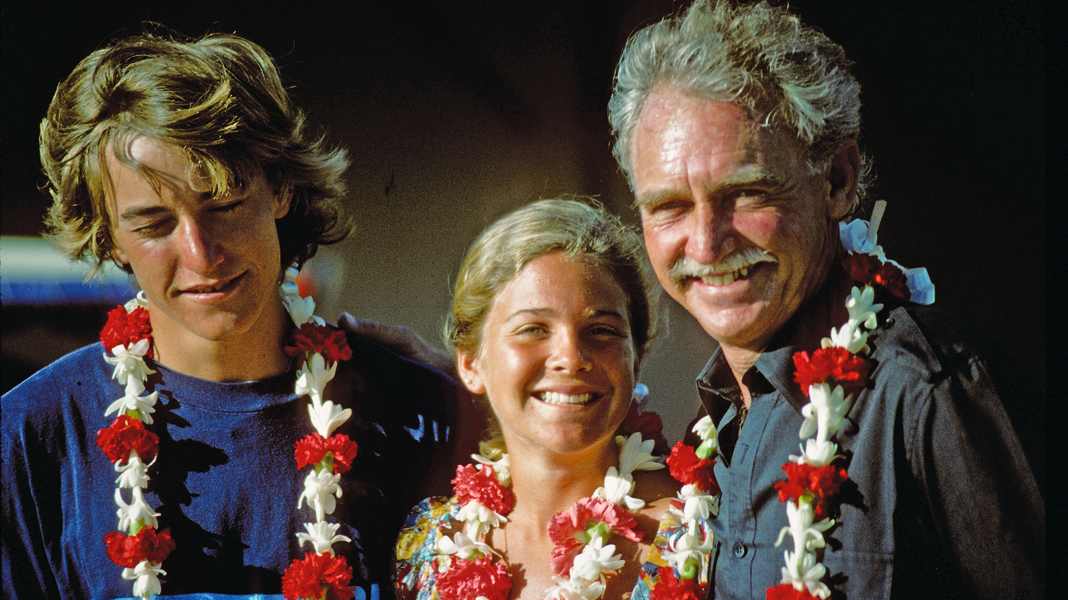
In May 1967, Jim Drake launched the first prototype of the windsurfer in Santa Monica, California. "The rest is history," says his son David in this interview. But we want to know a little more about how the history of windsurfing developed from the Drake family's perspective. David was one of six children. He and his older brother Alex tell us what it was like to grow up with the forefather of windsurfing.
Jim had six children. How did you and your siblings grow up?
We grew up in a valley of Santa Monica in Los Angeles in a house that my father designed and built and where windsurfing was invented. Progressive West Los Angeles was known for its very forward-thinking politics and breathtaking beauty. The six of us kids could be at the beach in ten minutes or in beautiful parks in the same amount of time if we walked in the other direction.
We had a very modern upbringing and lived quite close to nature, even by Californian standards. My mum collected greens from the creek, which we ate, and our family spent a lot of time together outdoors. When we weren't camping in Baja California, it was usually in Joshua Tree National Park. We were junior lifeguards, surfed, skateboarded, swam, climbed, sailed or travelled on bikes. The only thing we didn't have much in mind was organised team sports. Windsurfing was the perfect fit for our lifestyle.
Jim's main profession was aerospace engineer. Did he invent other things before the windsurfer?
He worked for a private high-tech company that developed military aircraft and ballistic missiles for the US Department of Defence. 15 years before he invented windsurfing, he left Stanford University with a degree in mechanical engineering specialising in aeronautical design. He was then recruited by the company North American Aviation. There he became head of a research group that invented X-15 rocket planes. These were high-speed aeroplanes that went beyond anything known from aircraft construction in terms of design. It was more of a spacecraft because it flew outside the atmosphere and still holds the records for speed and altitude for manned aircraft. So you could say that Jim has always thought outside the box.
The rocket designer who loved the sea
When we think of inventors, we tend to think of Daniel Gyro Gearloose. Was Jim a crazy guy?
Many outstanding engineers are perhaps eccentric and lack social skills. But that is not at all the case with my father. I have never met another person as social as Jim. He radiated a natural self-confidence and had such an incredible coolness, which he drew from his exceptionally high intelligence and decades of diverse experiences. He was a lifelong lover of the ocean as well as a gifted rocket designer, and the windsurfer combined these two passions seamlessly.
Here in America, we have an advert for a Mexican beer featuring a guy they call "The World's Most Interesting Man". He's a relaxed and educated older adventurer who is just as comfortable playing extreme sports as he is having lunch with a couple of martinis with the president of a country. This guy describes my father pretty well, I think. He was a very warm-hearted, handsome, athletic Californian original.
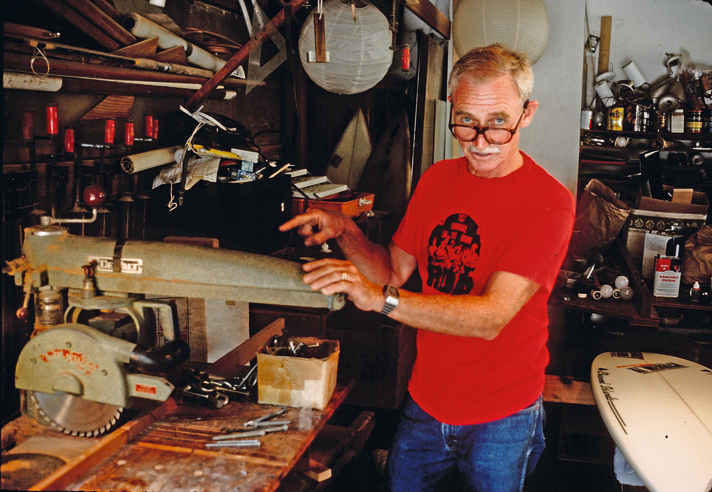
How did this attitude affect your life?
Almost all of our neighbours were very interesting people. Around us lived famous Hollywood actors, scientists who had won Nobel prizes. Our small social network actually had a significant influence on the world of engineering, art, medicine, space travel, film, music and many other areas of life. It was a real creative melting pot. My mum regularly threw parties where families would get together, we kids would go surfing on the beach and the adults would share their ideas. It was in this environment that the Drake and Schweitzer families became friends and Jim first revealed to Hoyle Schweitzer his idea of a sailing craft with a free-moving rig, which later led to the windsurfer. It was this bunch of intellectual, sea-loving families that made the rise of windsurfing possible.
How the first windsurfing board was created
Did Jim just build the windsurfer in your garage?
He had a really impressive workshop in our garage where he built the individual parts for the prototype himself. His ability to create things that combined beauty and function always impressed me. He constructed the first gimbal for the mast base from recycled steel from the navy. For the boom, he cut the wood to size, glued it in layers and bent it into the right shape. He laminated the centreboard first from pine and later from teak. The first board was a modified tandem wave riding board from a local surf shop. Our address in Santa Monica was also the first business address of "Windsurfing International", the company that Jim had founded with his friend and business partner Hoyle Schweitzer.
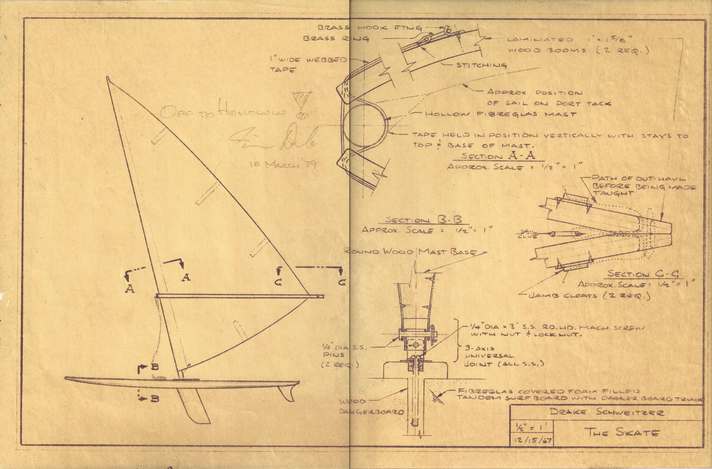
Was Jim Drake always convinced that his idea would work, or did he sometimes doubt it?
Even before the first tests, Jim was sure that it would work. But a funny story describes how he hadn't thought of everything. Jim had always imagined that the sail was in the surfer's hands, but he had never thought about how it would get there. And so it was that during the first test of the prototype, the sail was in the water and Jim realised that he didn't have a line to pick it up. Luckily Bob Broussard, the sailmaker who had made the first sail for the windsurfer prototype, was on the beach with him and he was able to get the rig upright in shallow water and hand it to Jim. The next day Jim had built a furling line on the rig and off we went. If you are interested. There is a short video on YouTube documenting the first attempts on the water.
Who else was involved in the development of the windsurfer. In old issues I read names like Fred Payne, Alan Parducci, the sailmaker Bob Broussard and of course Hoyle Schweitzer. What influence did they have?
Fred Payne was a colleague of Jim's from the early 60s. Fred lived in a small house right on the Potomac River in Washington D.C. The inspiration for the invention of the windsurfer came from a discussion between the two of them about a small, transportable sailing craft on which the sailor should stand and not sit. They wanted to create something that could be carried and assembled by just one person and easily launched on the river behind Fred's house. Their vision was a free-moving sail that would eliminate the need for a rudder.
The sticking point was the gimbal that could be turned in all directions, allowing the sail to be held in the hand. This discussion took place deep into the night at Jim's house in Santa Monica under the influence of a few Remy Martin cognacs. Jim later realised that alcohol corrupts intelligence and what seemed like a dazzling idea during the drunken night often turned out to be far less brilliant than expected when sober the next day. Jim loved engineering puzzles and so he never gave up on the concept. Years later, he told Hoyle Schweitzer about his idea at a party and he encouraged him to build a prototype and see if his concept really worked. Jim did and the rest is history.
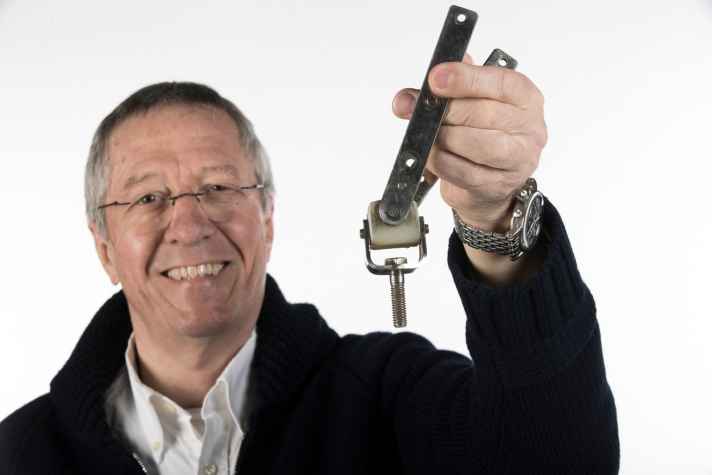
When windsurfing came to Europe, Hoyle Schweitzer was regarded as the inventor of the sport, who also held the patent and granted licences to European manufacturers or not. Many manufacturers took legal action against what they considered to be arbitrary licences. The issue filled many metres of folders at lawyers and courts. It was only research by the founder of surf magazine, Uli Stanciu, that brought to light the fact that Jim Drake was the actual inventor of windsurfing. Jim had ceded his half of the windsurfer's patent to Hoyle for little money, it was said at the time. How did you experience the situation?
The original history of windsurfing is partly shrouded in a kind of political and journalistic fog. This makes it quite difficult to document the history objectively. There are always several sides to a story and everyone has the freedom to tell their version. But in my opinion, the facts show without a doubt that Jim is the real inventor of windsurfing. However, I also believe that Hoyle Schweitzer played a significant role in the rapid spread of windsurfing. Without the unique skills of Jim and Hoyle, the idea would probably never have become the great sport that we still love so much 50 years later.
Jim and Hoyle met through their wives and, as I said, Hoyle encouraged Jim to realise his idea. As far as I know, Hoyle had nothing to do with the actual development, except that he obtained a used mast from a racing dinghy on Jim's behalf. Jim then gave it to sailmaker Bob Broussard, who cut the first sail on it. Hoyle was not involved in the development of the original windsurfer, nor was he in the workshop with Jim or present at the maiden voyage in Marina del Rey in May 1967. Hoyle had a close friend who was a patent attorney. They drafted a patent specification, the main content of which was Jim's original design. The patent was recognised and the names Drake and Schweitzer were registered as joint inventors.
Jim Drake vs. Hoyle Schweitzer: The dispute over the windsurfing patent
Hoyle had just lost his job as a computer salesman. Jim's career as an aerospace engineer, on the other hand, went through the roof. He was sent to the Pentagon to design a missile defence system for the government. During his absence, he left the prototype and also the company Windsurfing International, which he had co-founded with Hoyle, in Hoyle's capable hands. As soon as Jim was temporarily thousands of kilometres away from home in Washington D.C., he received a call from Hoyle. He urged him to sell him his half of the patent. Hoyle was very persistent, cunning and businesslike. Gone was the friendliness that had previously characterised Hoyle, gone were the family ties between the women and children at the parties and trips to the beach. Overnight, Hoyle had turned from a close friend into a bullying entrepreneur who wanted to force Jim out of the company in order to reap the profits of the windsurfer's invention alone.
Overnight, Hoyle Schweitzer had turned from a close friend into a bullying entrepreneur
Jim was shocked and didn't want to agree to the buyout. He wanted to continue to see Hoyle as a friend and believed that friends support each other and act amicably. Drake was wrong. Schweitzer turned out to be deceitful and untrustworthy. He aggressively tried to force Jim out of the joint business. He had already arranged a lucrative deal with European importers and was preparing a large delivery of windsurfers behind Jim's back. Hoyle also concealed from Jim that he had already secured the licence rights for the Windsurfer brand in many countries around the world.
Hoyle's sales offers reached a moral low point when he offered Jim a job as a middle sales representative at "Windsurfing International", the company they had founded together, in return. Big business was Hoyle Schweitzer's only motivation and in the end Jim granted him his wish and sold him his half of the patent with no further obligations. Hoyle's misrepresentations of the facts at the time later led to a lawsuit against him - but that's another story. Today, fortunately, the disputes between the Schweitzer and Drake families are in the past. The next generation is looking ahead and trying to continue sharing the legacy of the sport. Svein Rasmussen, founder and head of Starboard, acted as a peacemaker between the two families.
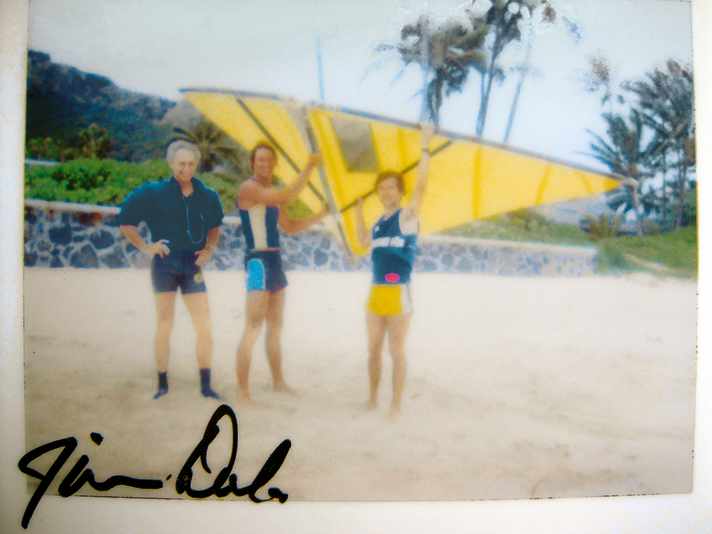
The Drake family's life revolves around windsurfing
Has the invention of the windsurfer changed the lives of the Drake children?
Windsurfing has dominated my life for the last 40 years. Of our six children, the three boys have dedicated a large part of their lives to windsurfing. My eldest brother Matthew was one of the top pros on the California Surf Sailor's Tour in the 80s. My brother Alex and I worked as windsurfing coaches at the Gorge in Hood River and coached around the world for Rhonda Smith and Vela Surf Centre. Today, Alex and I surf slalom boards almost daily in California and go stand-up paddling with family and friends. We also work as ambassadors for Starboard and test new design concepts for Svein Rasmussen. When time allows, we try to surf a few waves in Baja California.
How do you see your father in retrospect, what are you particularly proud of?
My two wonderful sisters Holly and Stephanie wrote me some lovely thoughts about their dad the other day:
'I'm proud of my father because windsurfing inspired him, but didn't define him. His modesty contrasted favourably with the complacency of others whose achievements simply paled in comparison to Jim's. He was well read, loved and aware that he was part of a legend. He was well read, loved and aware that he was part of a legend.' Holly
'All his answers to my questions were a little too long and too profound for my young age. But they made me feel important and loved.' Stephanie
I myself remember his great surfing style, which he still had when he was over 70 and which I always tried to copy. I can still hear him shouting his instructions to me across the water: 'Get stuck in'. Even in his old age, he was still able to develop sophisticated windsurfing and SUP boards for a leading brand. Many others have long since retired. And he was able to talk to everyone on the beach or at trade fairs at eye level - always without a trace of arrogance.
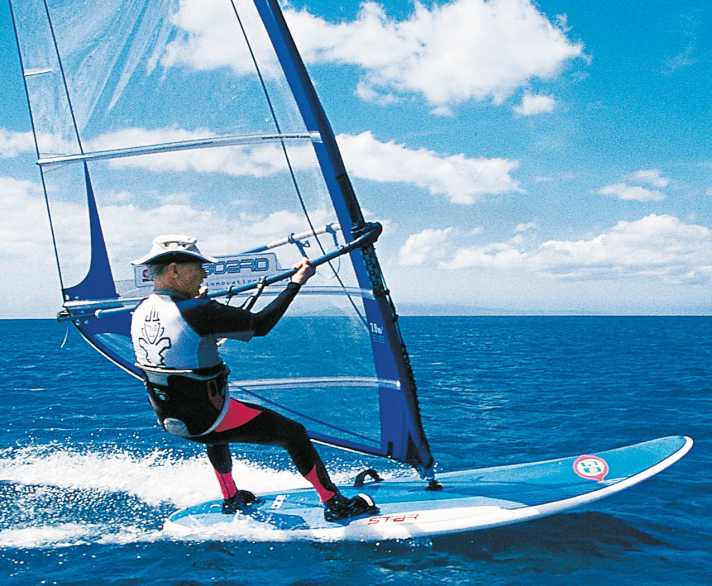
SUP and foiling: Jim Drake would enjoy modern windsurfing
How do you see the development of windsurfing, were there moments when it went in the wrong direction?
The sport grew so rapidly in the early years because many people took part in recreational regattas in the Windsurfer One Design Class with relatively little wind. The pure fun of being on the water with friends and family had a great charm. But the fair-weather sport of longboards was replaced by shortboards for high winds and high speeds on the water. In the arms race to make boards ever smaller and more manoeuvrable, windsurfing became very expensive and very specialised. The sport was pushed back to fewer and fewer places in the world that offered the perfect combination of lots of wind and warm water and was only of interest to die-hard fans and hardcore surfers. Windsurfing had lost its universal appeal of the early years.
Jim would have enjoyed bringing his engineering skills to the futuristic design puzzle of foiling.
That sounds a bit depressing. How will "windsurfing be great again"?
Windsurfing is magical. There is something deeply meditative about the feeling of flying over the glistening blue water, propelled by the power of the wind. It connects us to our environment in a creative and spontaneous way and gives us a feeling of carefree and pure life. Windsurfing provides our bodies with health and vitality. I think windsurfing will make a very strong comeback when people realise that they simply have to put a rig on a SUP board they've been paddling around on for years and quickly discover the fascination of windsurfing.
Jim Drake and Svein Rasmussen have worked closely together for over ten years, often leaving the beaten track. This resulted in short and wide, long and narrow boards, tandems and catamarans, to name but a few. Jim died in 2012 at the age of 83, just before the hydrofoil trend really took off. He would no doubt have enjoyed contributing his engineering skills to this futuristic design puzzle. Windsurfing's best days are yet to come. The best and brightest minds will continue to develop the sport with creative courage, collaboration and new inventions.
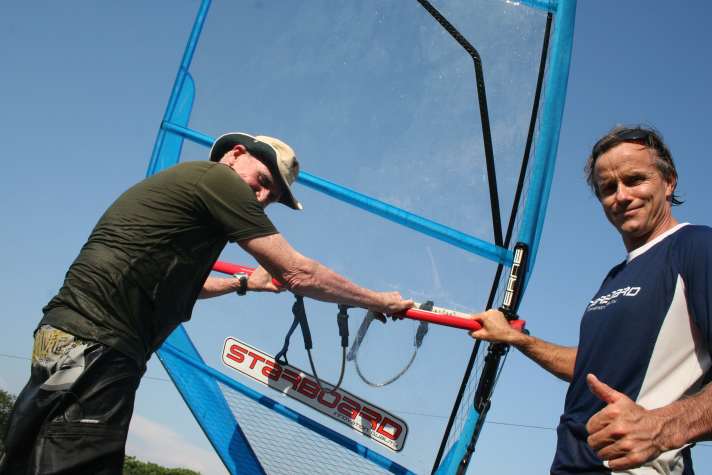
This interview first appeared in surf 3/2017 on the 50th anniversary of Jim Drake's first windsurfing attempt.

